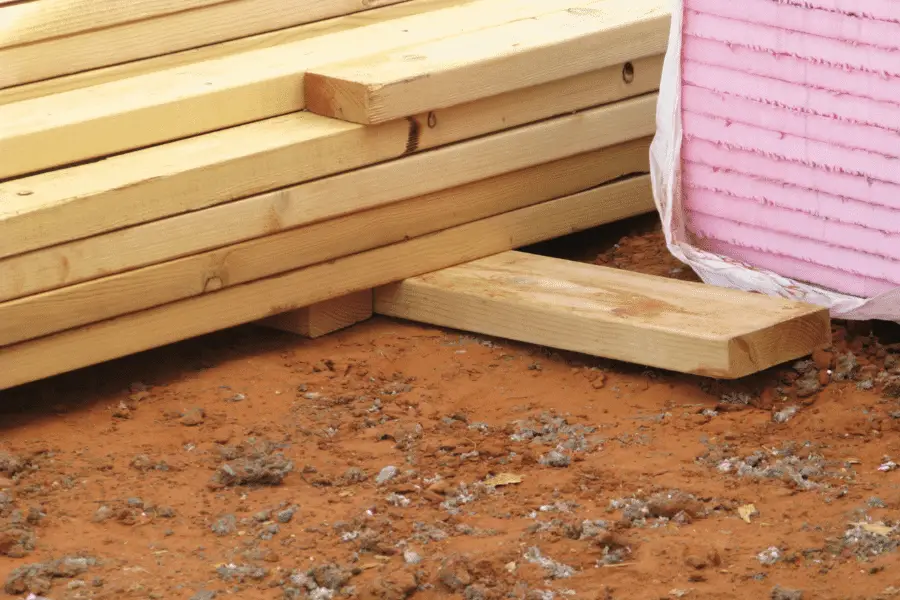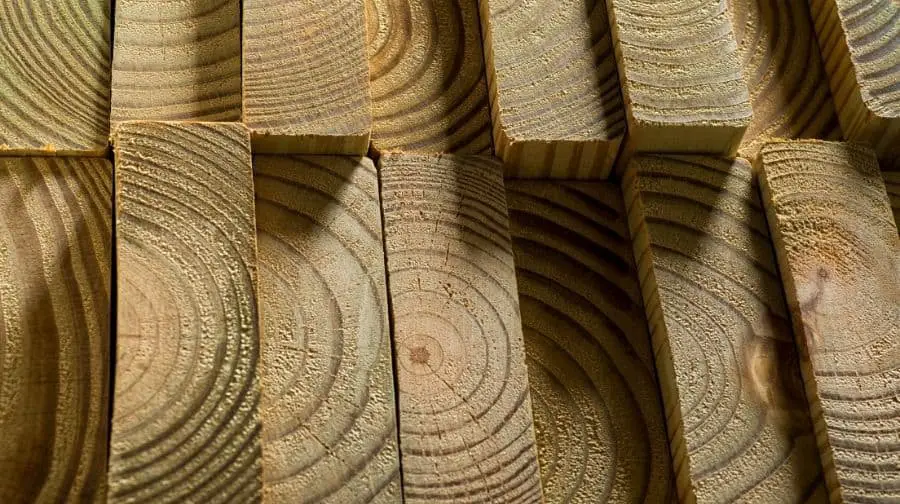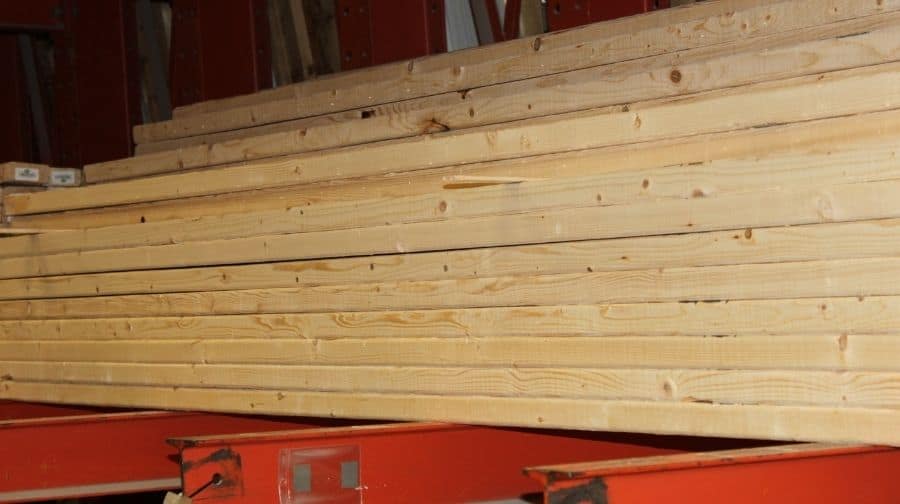
So, you want to start a project and need to know about 2×6 Lumber? Then you’re at the right place because we’re going to answer some frequently asked questions about it.
The project you are working on will dictate the type of Lumber you will want to use. Construction projects will require a different type of Lumber than something like furniture or novelty a project.
Hopefully, this will answer all your questions and help you to make an informed decision when looking for 2×6 Lumber. Let’s get started!
First, you need to understand the two main types of lumbers before deep-diving into the real topic.
What Are The Types Of Lumber?
Hardwood trees are angiosperms, that is, they produce seed-bearing fruits or nuts that must be removed or decayed before the seed begins growth. They are deciduous trees; in other words, they lose their leaves seasonally. Of the wide variety of hardwoods, only about 200 types are good for woodworking because of their abundant amount and the pliability.
Some prominent examples of types of hardwood are Ash, Bamboo, Basswood, Black Locust, Black Walnut, Cherry, Mahogany, Maple, Oak, Rosewood, Teak, Walnut, and White Oak.
Softwood trees are gymnosperms, which reproduce from uncovered seed. Softwood trees are also known as coniferous trees, or more commonly, evergreen trees and 25% of all softwood trees are used for woodworking. Researching the characteristics of any wood before beginning your project can save you time and money.
Some examples of softwood trees are Cypress, Douglas fir, and White Cedar.
Subscribe to Manovar production corporation – industrial wood on Youtube
What Are Lumber Grades?
Hardwood Lumber Grades
The National Hardwood Lumber Association grades lumber depending on the number of defects in the board. First and Second-grade lumber has a minimum board size of 6-in x 8-in and has a usable face material of 83% or higher.
Select grade lumber has a minimum board size of 4-in x 6-in and has a usable face material of 83% or higher.
Common grade has a minimum board size of 3″ x 4″ and has a usable face material of 66%.
Softwood Lumber Grades
Softwoods are divided into two categories: dimensional Lumber, with a grade based on strength, and appearance boards, which are typically used for woodworking projects.
Softwood Grading includes five grades.
C select grade is almost completely clear of defects. This grade is commonly used for interior trim and cabinet making.
D select grade has a fine appearance, very similar to C select grade, but may have dime-sized knots it the wood.
One Common grade is the best material for high-quality pine with a knotty look. These knots are usually tight and small, so you won’t have to worry too much about the knots falling out.
Two Common grade has tight knots, but are generally larger than that found in one Common. This grade is commonly used for shelving and paneling and is well suited for your general woodshop projects.
Three Common grade has larger knots than two commons. This grade may also be used for shelving and paneling and is very well suited for fencing, box making, and crate making.
Now hopefully you have a better understanding of the two types of wood and how they are graded, which will help you to understand about 2×6 Lumber and its uses.
How To Make Lumber With A Sawmill
Subscribe to Wranglerstar on Youtube
Some FAQ’s Regarding 2×6 Lumber
How Wide Is A 2×6?
For starters, it’s important to understand the wideness of Lumber and the difference between nominal and actual sizes. As the name reflects, 2×6 Lumber is 2″ thick and 6″ wide. Actually, it has 02 sizes which are:
- Nominal Size – 2″ x 6″
- Actual Size – 1.5” x 5.5”
Is A 2×6 Really 2×6?
There are two sizes available in the market; Nominal (Used for identification of a product) and Actual (Used to define the real on-site specification).
The nominal 2×6 lumber is somewhat larger than the actual size of 2×6 lumber because the nominal measurement was done before smoothing the surface, whereas the actual dimension measures after the planned processes is 1.5” x 5.5”.
How Much Does A 2×6 Weigh?
On average, it weighs 2 pounds per foot. The weight of a 2 x 6 lumber varies based on the type of Lumber and the moisture content of the Lumber.
Are 2 x 6 Lumber Walls Worth It?
Yes, using 2 x 6 Lumber allows more construction space and better insulation to your exterior walls, which may lead to cost reduction into utility bills. It’s resilient and the sturdiest for external wall construction.
Can I Use 2×6 For Deck Boards?
Yes, 2×6 Lumber is perfect for the preparation of deck boards. It’s recommended to use for ground floor decking only at a distance of 12 inches center to center.
Can I Use 2×6 For Deck Joists?
You can definitely use 2×6 Lumber for deck joists with a maximum allowable span of 10 feet at 12″ c/c, 9 ft at 16″ c/c, and 7.5′ at 24″ c/c.
Joists are the repetitive wooden structural members that are used to build a deck board. The minimum size of joist depends on the number of beams and footing used in the preparation or installation of decks.
According to the thumb rule, the larger the deck the larger would be the spacing.

Can I Use 2×6 For Rafters?
You can simply use 2×6 Lumber for rafters in the preparation of 3/12″ pitched roof or shed. For sheds that won’t be exposed to heavy wind or snow loads, a span up to 20′ with 2×4 rafters can be used, whereas for sheds that will experience heavy wind or snow load the same distance, use 2×6 rafters.
How Much Weight Can A 2×6 Support Horizontally.
To give you a general idea, it can easily sustain a 40Lbs Live Load (Dynamic Load) and 10psf (Static load) Dead Load. It’s more than enough to sustain the load of 600-700 lbs. 4-cylinder to v8 engine comfortably.
The strength or load-bearing capacity of 2×6 lumber beam varies based on different aspects, such as quality, thickness, seasoning, grade, and else. As such, the question of how much weight can a 2×6 support horizontally may have varied answers.
How Far Can A 2×6 Span Without Support?
The allowable span limit for 2×6 Lumber is not more than 10′, measures at a distance of 12″ center to center spacing.
How Many 2×6 In A bundle?
For 2×6 Lumber, there are 128 pieces in a bundle, which measures around 20′ high and 8′ wide to facilitate the hauling. The cost of 2×6 Lumber varies around $3 to $3.5 of 8ft in length and $4.75 to $5.25 of 12ft length.
How To Reinforce 2×6 Ceiling Joists?
Use 06 Nos. of 10d nails with plywood gussets, or 06 Nos. of 16d nails with 2x4s, half into each 2×6 joist. That’s traditional nailing in terms of the capacity of the ties, but it also keeps the gussets from twisting.
How Much Weight Can A 2×6 Support?
The type of weight in question will also govern how much weight a 2×6 can hold on edge.
For example – To give you a clear picture, 2×6 Lumber can easily sustain a load of v8 engine, which may range from 600 – 700 lbs. The depth of each structural member will also be a key player here because 2×6 spaced 24″ apart provide more strength than 36″ spaced apart. Further, you also need to check how it’s framed with your roof/ceiling because it also strengthens their capacity.

What Size Deck Screws To Use For 2×6?
For decking 2×6 Lumber, it’s advisable to use 1-1/2″, 2-1/2″, or 3″ decking screws. No need to use extra-large screws, because the screw will typically break before they pull out of the wood.
Can You Use 2×6 Tongue And Groove As Decking?
Of course, yes! Creating a deck with tongue groove via 2×6 Lumber is as easy as creating a deck with traditional boards. First, cut all your pieces into suitable lengths then apply a coat of sealer to intact its moisture and start fitting boards into one another.
What Is 2×6 Pressure Treated Lumber?
In pressure treatment, softwood lumber is used, typically yellow pine, that’s been chemically treated to fight rot, decay and termites. The boards are treated into gigantic pressurized treatment tanks where chemical additives are injected deep into the wood’s fibres, making it more durable and resilient than ordinary 2×6 lumbers.
2×6 Wall Insulation
2×6 lumber walls are better than 2×4 lumber walls, especially for insulation. You can add 2″ to 3″ closed-cell insulation foam, making it incredibly good to the headers over windows and doors to help cut down on energy bills.
2×6 Framing
In general, 2×6 lumber is better for framing as compared to 2×4 pieces. The load-bearing capacity of 2×4’s is 15.75 square inches, whereas the 2×6 lumber possesses the load-bearing area of 16 square inches.
However, a 2×6 wall is considerably stronger. In tall walls, where column buckling might be a factor, a 2×6 wall would be more substantial if a structural sheathing was used.
Subscribe to Matt Risinger on Youtube
2×6 Hangers
The hangers made of 2×6 Lumber can be used anywhere just to strengthen the load-bearing capacity of connections. It uses face mount attachments to fasten joist ledger beams and boards. Many woodworkers underestimate the importance of hangers while selecting the right one.
Now hopefully you have a better understanding of 2×6 lumber and its uses. We hope this information will help you make an informed decision about the type of wood needed for your project.
